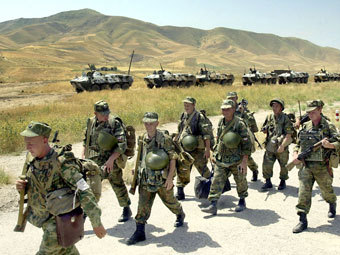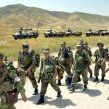
Russia Losing Ground Across Central Asia
Publication: Eurasia Daily Monitor Volume: 13 Issue: 26
By:

Increasingly, it seems that wherever one looks in Central Asia, Russia is losing ground. This retreat is not confined to economics, though it is certainly present in this sphere. Notably, Moscow is also finding it increasingly difficult to compete militarily in Central Asia. For example, in Tajikistan, Moscow is downgrading to a brigade the size of its 201st division, based just outside of Dushanbe, after having moved a Russian regiment away from the border with Afghanistan in December. This reduction in status and in numbers flatly contradicts earlier statements, made in 2015, that the number of Russian forces stationed in this small Central Asian republic would be raised from 5,900 to 9,000, due to mounting anxiety about the reported growing presence of the Islamic State (IS) organization in Afghanistan (Yezhenedevnyi Zhurnal, February 4). Although the reasons for this recent force reduction have not been made clear, the policy move unmistakably flies in the face of Russia’s escalating rhetoric about the threat from the IS in Central Asia and Afghanistan as well as the deteriorating regional security situation there. Top Russian officials, including Defense Minister Sergei Shoigu, had routinely raised concerns about the Islamic State’s ostensibly growing penetration of Afghanistan (Gazeta.ru, December 24, 2015).
Despite these heightened threat warnings coming out of Moscow, it appears that Tajikistan and Turkmenistan—two states that directly border Afghanistan and would be in the direct path of any northward terrorist surge coming out of this country—do not actually want more Russian troops on their soil. Yet, at the same time, these Central Asian republics lack the means or will to defend themselves directly against the Islamic State (see EDM, January 12). Moreover, experts generally discount the capacities of the Russian-led Collective Security Treaty Organization (CSTO) to defend the area as well (Gazeta.ru, December 24, 2015).
Tumbling commodity prices (not just hydrocarbons) and the depressed Russian economy are having a serious impact on Moscow’s policy toward and presence in Central Asia. For one thing, the withering economic crisis has forced Central Asian guest workers in Russia to return home, and for remittances to their home countries to dry up (see EDM, September 15, 2015). Furthermore, Russia is pulling back from investment commitments it made to Central Asian governments (Azattyk.kg, December 31, 2015). This has notably led Kyrgyzstan to denounce its agreements with Russia on the major hydropower project Kambarata GES-1 and a cascade of such planned hydroelectric stations on the Upper Naryn River (Vechernyi Bishkek, December 24, 2015; Regnum, January 1, 2016; see EDM, January 15). As a result, not only are major regional investment projects being suspended, the local governments are now left to grapple with serious environmental and economic problems that have been aggravated by Moscow’s inability to live up to its defense and economic commitments.
The “commitment problems” Russia is now encountering may perhaps provide one possible explanation for the recent revelation that Moscow is reportedly sharing intelligence with the Taliban against the Islamic State. The Taliban—heretofore frequently cited as a threat to Central Asia that necessitated greater Russian security involvement in the region (see Terrorism Monitor, March 20, 2015; EDM, October 22, 2015)—is evidently opposed to restoring the broader Islamic Caliphate across Afghan territory. Thus, the Taliban’s interests in this instance objectively coincide with those of Russia against the Islamic State (Russianews.net, December 26, 2015). Moscow has also now said it might be “flexible” with regard to the easing of United Nations sanctions against the Taliban—undoubtedly a quid pro quo for this intelligence sharing (The Moscow Times.com, December 29, 2015).
Finally, both the use of the Russian language in Central Asia and the number of ethnic Russians still living there is falling dramatically. The size of the Russian population across the region has dropped by around 50 percent since the collapse of the Soviet Union. Together, these linguistic and demographic trends provide another basis for the reduction of Russian influence across Central Asia (see EDM, February 2).
Thus, one can discern a steady and long-term trend of the diminution of Russia’s military, political, economic and cultural power throughout Central Asia. And this trend has possibly speeded up due to the economic crisis in Russia and the wider post-Soviet space. It is far too early to state who will be the beneficiary of this Russian retrenchment from the region; though it is clear that, by several measures, China has already outstripped Russia economically in Central Asia (see EDM, July 6, 2015; China Brief, March 19, 2015). Moreover, it is likely that as China’s geo-economic investments in Central Asia grow—and they have not slowed down yet despite China’s own crisis—Beijing may begin to feel the need to initiate corresponding investments in military power to ensure the safety and stability of those business deals. If they can remain stable and overcome their present economic crises, the Central Asian governments might also benefit from Russia’s shrinking regional presence. On the one hand, they will gain more sovereignty. But at the same time, these republics will need to take more responsibility for their own security instead of outsourcing or sub-contracting it to a Russia that cannot and will not stand by its commitments.
It is, of course, possible that terrorist and militant groups—the Islamic State or others affiliated with it—might themselves gain form this Russian retreat. But for all the invocations of a rising Islamist or terrorist threat in Central Asia, there are analysts, even in Russia, who remain skeptical that such groups will take over one or more country in this region (Ferghana.ru, December 22, 2015). Indeed, reliable evidence of a rising Muslim Islamic threat in Central Asia is still elusive; not one of these states or societies has succumbed to this threat so far. To be sure, the possible threat is real enough, but much of its substance appears to have been inflated for political purposes by various governments and military establishments, who have long since learned how to raise the alarm and fool the credulous (see Terrorism Monitor, March 20, 2015). While Central Asian governments face real problems, it is also increasingly clear that they have no choice but to deal with them—and most probably will.




